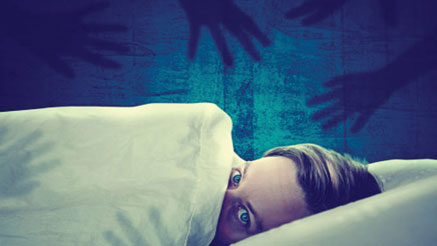Sleep paralysis is a feeling of being unable to move, either at the onset of sleep or upon awakening. The individual's senses and awareness are intact, but they may feel as if there is pressure on them, or as if they are choking. It may be accompanied by hallucinations and intense fear.
Sleep paralysis is not life-threatening, but it can cause anxiety. It can happen alongside other sleep disorders, such as narcolepsy. It often starts during adolescence, and it can become frequent during the 20s and 30s. It is not a serious risk.
Fast facts on sleep paralysis
Here are some key points about sleep paralysis:
- Sleep paralysis is most likely to occur during adolescence.
- Episodes last from a few seconds to a few minutes.
- Stress, jet lag, sleep deprivation and panic disorder may trigger it.
- An inability to move or speak is an essential feature, and there may be hallucinations.
- It is not physically harmful and it can be prevented.
What is sleep paralysis?
Sleep paralysis is a parasomnia, or an undesired event that is associated with sleep. It happens just after falling asleep or upon awakening in the morning, in the time between waking and sleep. Episodes are often accompanied by hypnagogic experiences, which are visual, auditory, and sensory hallucinations.
These occur during the transition between sleeping and waking, and they consistently fall into one of three categories:
Intruder
There are sounds of doorknobs opening, shuffling footsteps, a shadow man, or sense of a threatening presence in the room.
Incubus
Feelings of pressure on the chest, difficulty breathing with the sense of being smothered, strangled or sexually assaulted by a malevolent being. The individual believes they are about to die.
Vestibular-motor
A sense of spinning, falling, floating, flying, hovering over one's body or another type of out-of-body experience.
The experience of sleep paralysis has been documented for centuries. People from different cultures have similar experiences. Sleep paralysis is brief and not life threatening, but the person may remember it as haunting and horrifying.
Causes
While sleeping, the body relaxes, and voluntary muscles do not move. This prevents people from injuring themselves due to acting out dreams. Sleep paralysis involves a disruption or fragmentation of the rapid eye movement (REM) sleep cycle.
The body alternates between rapid eye movement (REM) and non-rapid eye movement (NREM).
One REM-NREM cycle lasts around 90 minutes, and most of the time spent sleeping is in NREM. During NREM, the body relaxes. During REM, the eyes move quickly, but the body is relaxed. Dreams occur at this time.
In sleep paralysis, the body's transition to or from REM sleep is out of sync with the brain. The person's consciousness is awake, but their body remains in the paralyzed sleep state.
The areas of the brain that detect threats are in a heightened state and overly sensitive.
Factors that have been linked to sleep paralysis include:
- Narcolepsy
- Irregular sleeping patterns, due, for example, to jet lag or shift work
- Sleeping on your back
- A family history of sleep paralysis
Sleep paralysis can be a symptom of medical problems such as clinical depression, migraines, obstructive sleep apnea, hypertension, and anxiety disorders.
Signs and symptoms
An inability to move the body when falling asleep or on waking, lasting for seconds or several minutes
- Being consciously awake
- Being unable to speak during the episode
- Feeling pressure on the chest
- Having difficulty breathing
- Feeling as if death is approaching
- Sweating
- Having headaches, muscle pains, and paranoia
Everyday non-threatening sounds, sensations, and other stimuli that the brain normally ignores become disproportionately significant.
Diagnosis
- Medical attention may help when:
- Sleep paralysis happens regularly
- There is anxiety about going to sleep or difficulty falling asleep
- The individual falls asleep suddenly or feels unusually sleepy during the day
Suddenly falling asleep during the day could be a sign of narcolepsy, a rare brain disorder that causes a person to fall asleep or lose muscle control at unexpected or inappropriate times.
If stress or anxieties are present, addressing these may help relieve symptoms.
Courtesy: Medical News Today

